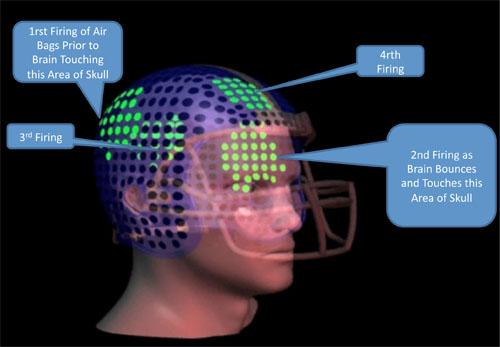
A startup company in Colorado wants to take the concept of the smart football helmet a step further by enabling it to pop open dozens of tiny airbags and cushion the blow of a hard hit to the head.
Concussion Mitigation Technologies LLC is proposing to equip future helmets with enough electronic intelligence to enable them to measure a hit, compare it to pre-determined criteria, and intelligently pressurize as many as 75 dime-sized airbags. Troy Fodemski, founder of the fledgling company, believes the technology will help professional and amateur sports deal with growing concerns about head injuries.
"The human brain wasn't made to withstand 80 Gs in 15 milliseconds," Fodemski, an electrical engineer, told Design News. "If we want to compete in contact sports with a human brain, then we're going to have to use sophisticated data collection, modeling, and response techniques."
The company's football helmet, which hasn't yet been fully prototyped, will incorporate multiple strain gages, a small cartridge of carbon dioxide (CO2), scores of tiny airbags, a lithium battery, and a printed circuit board with a microprocessor, memory, and analog-to-digital converters. On the field, the helmet will use the strain gages to measure the impact of hit. Then it will send the data to the microprocessor, compare it to software models in memory, and pressurize the airbags with CO2 when necessary.
"When the player gets hit, the helmet will compare the data to numbers in a look-up table," Fodemski said. "It will say, 'The player has been hit in quadrant XYZ of his brain, and the brain will move 11 times.' Then it will fire off the airbags in sequence to respond to the movement of the brain."
The technology faces multiple hurdles -- cost, complexity, and practicality, to name just a few. Still, it comes at a time when professional and amateur sports are facing a growing body of knowledge suggesting that head injuries and concussions have long-term effects on the brain that haven't been fully understood up until now. As a result, NFL head-trauma lawsuits now number in the hundreds, and deaths of former stars, such as Junior Seau, Mike Webster, and Dave Duerson, are being viewed in the context of severe repeated concussions. The same has happened in the National Hockey League, where deaths of several notable former players in 2011 further heightened concerns.
Fodemski's solution would mitigate damage to the brain by firing the airbags when the brain is about to hit the inside of the skull. The company says that its airbags would provide inward force, serving to nudge the brain back to neutral sooner, rather than having to wait for eight or 10 more collisions while the brain moves back and forth. "All leading theories say that the axons -- the wires between the neurons -- are tearing," Fodemski said. "In some cases, the axons can regenerate or repair. In some cases, they can't. But eventually, you exhaust the brain's capacity to repair the neuro-pathways."
Fodemski's idea builds on earlier work done at Virginia Tech and at other universities, where engineers fitted helmets with accelerometers and associated electronics to monitor impact on players. The smart helmets showed that some particularly hard hits resulted in accelerations of 100 Gs or more to the head.
Fodemski said he doesn't yet know what his football helmets will cost, but it's believed that they could run several times as much as today's helmets, which often cost between $175 and $300. Concussion Mitigation Technologies also hopes to place the technology in other sports, such as hockey, baseball, and skiing, as well as in the military. Initial prototypes for football are expected to be ready in about six months. "It's time to start thinking bigger about this issue," Fodemski said. "We're talking about the brain, which is an organ that can't be replaced."
Read more here
No comments:
Post a Comment